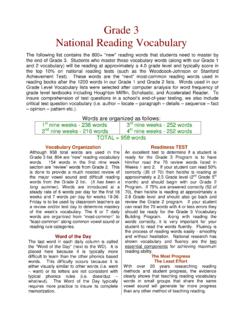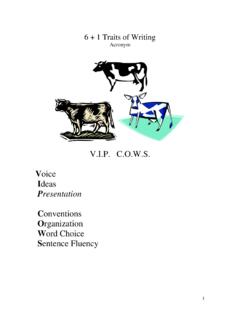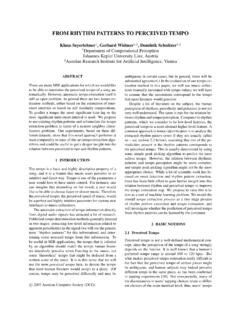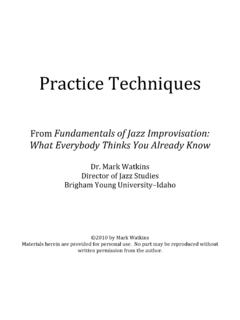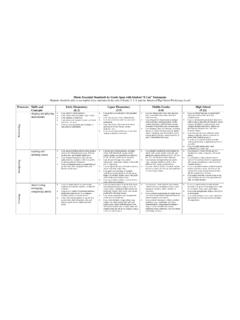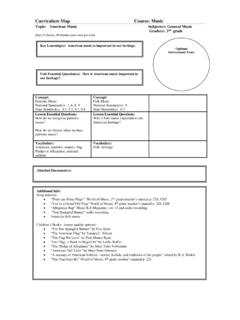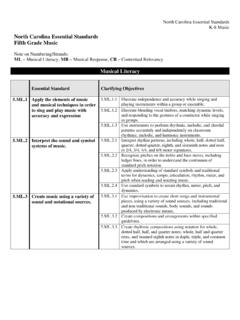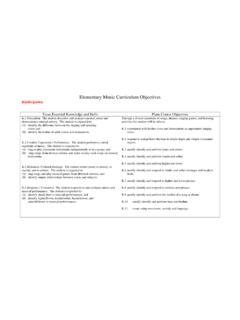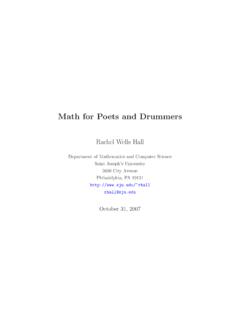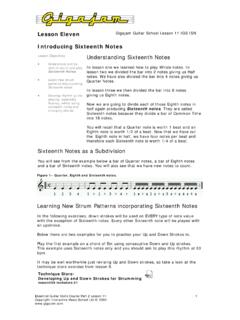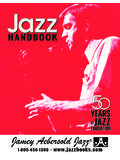Transcription of Geneva CUSD 304 Content-Area Curriculum Frameworks …
1 Orchestra 8th grade Page 1 of 7 August 2008 Geneva CUSD 304 Content-Area Curriculum Frameworks Grades 6-12 Orchestra Quarter 1 Mission Statement The mission of the Geneva CUSD 304 K-12 music education Curriculum is to guide all students toward the development of a lifelong personal relationship with music, by giving every student the opportunity to develop his or her individual skills, talents, and knowledge of music to the fullest potential, through a variety of appropriate listening, performance, creative, evaluative, and learning experiences. Orchestra Music education in the public school exists for the purpose of awakening and refining the aesthetic sensitivity of all students. The string program should develop musical skills on string instruments, understanding and attitudes that will enable a student to enjoy a richer life through listening to and or participating in musical experiences in today s society.
2 Course Sequence (Grades 6-12) 6th grade orchestra. 7th grade orchestra. 8th grade orchestra Concert Orchestra (9th-12 grade ) Symphony Orchestra (9th 12 grade ) by audition. Chamber Orchestra (10th-12th grade ) by audition. Orchestra 8th grade Page 2 of 7 August 2008 Course framework Course Title grade Level Semesters (1-2-3- 4) Prerequisite Orchestra 8th grade 2 semesters 7th grade orchestra or equivalent Course Description Eighth grade orchestra is a continuation of seventh grade orchestra. Curriculum emphasis is on reviewing and refining the intermediate techniques of better tone production, shifting to higher positions, and introduction of advanced techniques. Study of music theory and ear training continues and ensemble music in four and five and six part harmonies is performed. Chamber Music unit is included during which students perform in string quartets and other various small ensembles.
3 All students receive small group lesson instruction during the school year. Enrichment opportunities include fiddle Club, Solo and Ensemble and IMEA orchestra auditions. District-approved Materials and/or Resources Essential Technique for Strings 2000, Book 3 Daily Warm-ups by Michael Allen Winning Rhythms Rhythm flash cards Selected string orchestra arrangements, grade 2 -3 Rhythm Sessions by Gearhart Orchestra 8th grade Page 3 of 7 August 2008 Orchestra grade 8 Quarter 1 Unit of Study: major topics Major two octave scales, C, G, and arpeggios 4/4, 2/4, , 6/8 time signatures Complex rhythm patterns, bowings, and various key signatures included in Daily Warmups Vibrato review Orchestra literature grades 2-3 Fiddle music and alternative styles Resources that will support instruction Essential Technique 2000 for Strings, Book 3 Winning Rhythms Rhythm flash cards Selected string orchestra arrangements, grade 2-3 Small group lessons.
4 Illinois Learning Standards, Benchmarks, National Standards Assessment Frameworks , or other standards that will be taught in this unit Based on the Following National Standards for Music Education 1. Sings, alone and with others, a varied repertoire of music. 2. Performs on instruments, alone and with others, a varied repertoire of music. 5. Reads and notates music 7. Evaluating music and music performance. Learner Outcomes Demonstrate through performance two octave C, G scales and arpeggios. Analyze key signatures from above scales and apply with correct finger patterns to orchestra literature and solos. Apply understanding of rhythm concepts to performance of orchestra literature. Apply/demonstrate bowing patterns studied to orchestra literature and solos. Demonstrate tuning of instrument using fine tuners and pegs.
5 Perform music in four and five parts. Assessments Performance Tasks Worksheets on syncopated rhythms and tempo markings Written quizzes on syncopated rhythms and tempo markings Performance quizzes. Other Evidence Teacher will observe and correct daily in class. Orchestra 8th grade Page 4 of 7 August 2008 Orchestra grade 8 Quarter 2 Unit of Study: major topics Major two octave scales, C, G, D, A and arpeggios 4/4, 2/4, , 6/8 time signatures Complex rhythm patterns, bowings, and various key signatures included in Daily Warm-ups Vibrato review Orchestra literature grades 2-3 Fiddle music and alternative styles Resources that will support instruction Essential Technique 2000 for Strings, Book 3 Winning Rhythms Rhythm flash cards Selected string orchestra arrangements, grade 2-3 Small group lessons.
6 Illinois Learning Standards, Benchmarks, National Standards Assessment Frameworks , or other standards that will be taught in this unit Based on the Following National Standards for Music Education 3. Sings, alone and with others, a varied repertoire of music. 4. Performs on instruments, alone and with others, a varied repertoire of music. 6. Reads and notates music 7. Evaluating music and music performance. Learner Outcomes Demonstrate through performance two octave C, G, D, A scales and arpeggios. Analyze key signatures from above scales and apply with correct finger patterns to orchestra literature and solos. Apply understanding of rhythm concepts to performance of orchestra literature. Apply/demonstrate bowing patterns studied to orchestra literature and solos. Demonstrate tuning of instrument using fine tuners and pegs.
7 Perform music in four and five parts. Assessments Performance Tasks Worksheets sharp and flat key signatures Written quizzes on sharp and flat key signatures Performance quizzes. Other Evidence Teacher will observe and correct daily in class. Orchestra 8th grade Page 5 of 7 August 2008 Orchestra grade 8 Quarter 3 Unit of Study: major topics Major two octave scales, C, G, D, A, F, and Bb scales and arpeggios 4/4, 2/4, , 6/8 , 12/8 time signatures Complex rhythm patterns, bowings, and various key signatures included in Daily Warm-ups Vibrato review Orchestra literature grades 2-3 Fiddle music and alternative styles Resources that will support instruction Essential Technique 2000 for Strings, Book 3 Winning Rhythms Rhythm flash cards Selected string orchestra arrangements, grade 2-3 Small group lessons.
8 Illinois Learning Standards, Benchmarks, National Standards Assessment Frameworks , or other standards that will be taught in this unit Based on the Following National Standards for Music Education 5. Sings, alone and with others, a varied repertoire of music. 6. Performs on instruments, alone and with others, a varied repertoire of music. 7. Reads and notates music 7. Evaluating music and music performance. Learner Outcomes Demonstrate through performance two octave C, G, D, A, F, and Bb scales and arpeggios. Analyze key signatures from above scales and apply with correct finger patterns to orchestra literature and solos. Apply understanding of rhythm concepts to performance of orchestra literature. Apply/demonstrate bowing patterns studied to orchestra literature and solos. Demonstrate tuning of instrument using fine tuners and pegs.
9 Perform music in four and five parts. Assessments Performance Tasks Worksheets on how to form a major scale using whole and half steps. Written quizzes on how to form a major scale using whole and half steps. Performance quizzes. Other Evidence Teacher will observe and correct daily in class. Orchestra 8th grade Page 6 of 7 August 2008 Orchestra grade 8 Quarter 4 Unit of Study: major topics Major two octave scales, C, G, D, A, F, and Bb scales and arpeggios Minor scales (introduction) a, e, d,g 4/4, 2/4, , 6/8 , 12/8 time signatures Complex rhythm patterns, bowings, and various key signatures included in Daily Warm-ups Vibrato review Orchestra literature grades 2-3 Fiddle music and alternative styles Resources that will support instruction Essential Technique 2000 for Strings, Book 3 Winning Rhythms Rhythm flash cards Selected string orchestra arrangements, grade 2-3 Small group lessons.
10 Illinois Learning Standards, Benchmarks, National Standards Assessment Frameworks , or other standards that will be taught in this unit Based on the Following National Standards for Music Education 7. Sings, alone and with others, a varied repertoire of music. 8. Performs on instruments, alone and with others, a varied repertoire of music. 8. Reads and notates music 7. Evaluating music and music performance. Learner Outcomes Demonstrate through performance two octave C, G, D, A, F, and Bb major scales and arpeggios. Demonstrate through performance two octave a,e,d, and g minor scales Analyze key signatures from above scales and apply with correct finger patterns to orchestra literature and solos. Apply understanding of rhythm concepts to performance of orchestra literature. Apply/demonstrate bowing patterns studied to orchestra literature and solos.
